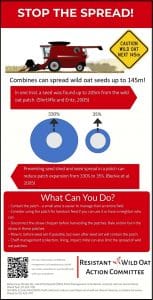While pre-harvest scouting for diseases and crop staging, keep a look out for weeds. Challenges with timely and effective weed control earlier in the season can result in more weeds than expected at harvest time. Large weeds at this point in the season raise three agronomy questions:
1. Should these weeds be controlled pre-harvest to improve the harvest process and to stop them from setting seed?
A pre-harvest application of glyphosate and possibly glyphosate + Heat can provide effective weed control that can make the crop easier to straight combine and control these weeds while they’re actively growing. This could also reduce the release of viable seeds back into the seedbank. Pre-harvest products and how to use them.
Pre-harvest glyphosate can be used to control weeds ahead of swathing, but the timing becomes a little tricker. Glyphosate has to be applied when seeds have less than 30 per cent moisture, which is around 50 to 60 per cent seed colour change in the least-mature areas of the field. This is also an ideal time to swath, but the glyphosate needs seven days to work and stay within pre-harvest interval guidelines. This delay could be worthwhile when the field has a lot of perennial weeds, which can be effectively controlled with a pre-harvest application.
2. If the weed seeds are mature, what can be done to minimize the spread of these seeds?
The combine can spread weed seeds a long way. A Manitoba study found that the combine can move seeds 145 metres from a patch, which is a more serious problem if those weeds are herbicide resistant. To prevent this spread, mow the patch before harvest to keep seeds contained within the same area. Another alternative is to drop the swath and chaff in these patches (disengage the spreader/chopper) and bale or burn it.
3. Why are the weeds there (and what could be done differently to prevent it from happening again)?
Weed competition is costly to yields, and if weed management practices aren’t working, it’s important to find out why. Try to find an explanation for each patch so you can take effective to remove the patch for next year.
Is the patch in a low spot that was too wet to seed? Was it a sprayer miss? Are the weeds growing because disease or salinity wiped out the crop? Did the weed emerge after in-crop control? Maybe the chosen in-crop herbicide doesn’t actually control these particular weeds? Were spray conditions, herbicide rates or water rates less than ideal for good control? Are the weeds herbicide resistant?
Clues that a patch of weeds are herbicide resistant: One, a patch of herbicide-resistant weeds has no clear boundary. (As Saskatchewan Agriculture weed management specialist Clark Brenzil describes, the patch will have diffuse boundaries that kind of follow machinery pathways, as the patch often spreads by the combine or soil-moving equipment spreading the seeds, but not distinct boundaries that we would see in a spray miss.) Two, the patch will be one species of weed that escaped the spray.
Dig deeper
- Suspicious weed patches: Check for resistance
- Best timing for perennial weeds: Pre-harvest or post-harvest?
- Whenever applying products close to harvest, check the pre-harvest interval with the Spray to Swath calculator.

